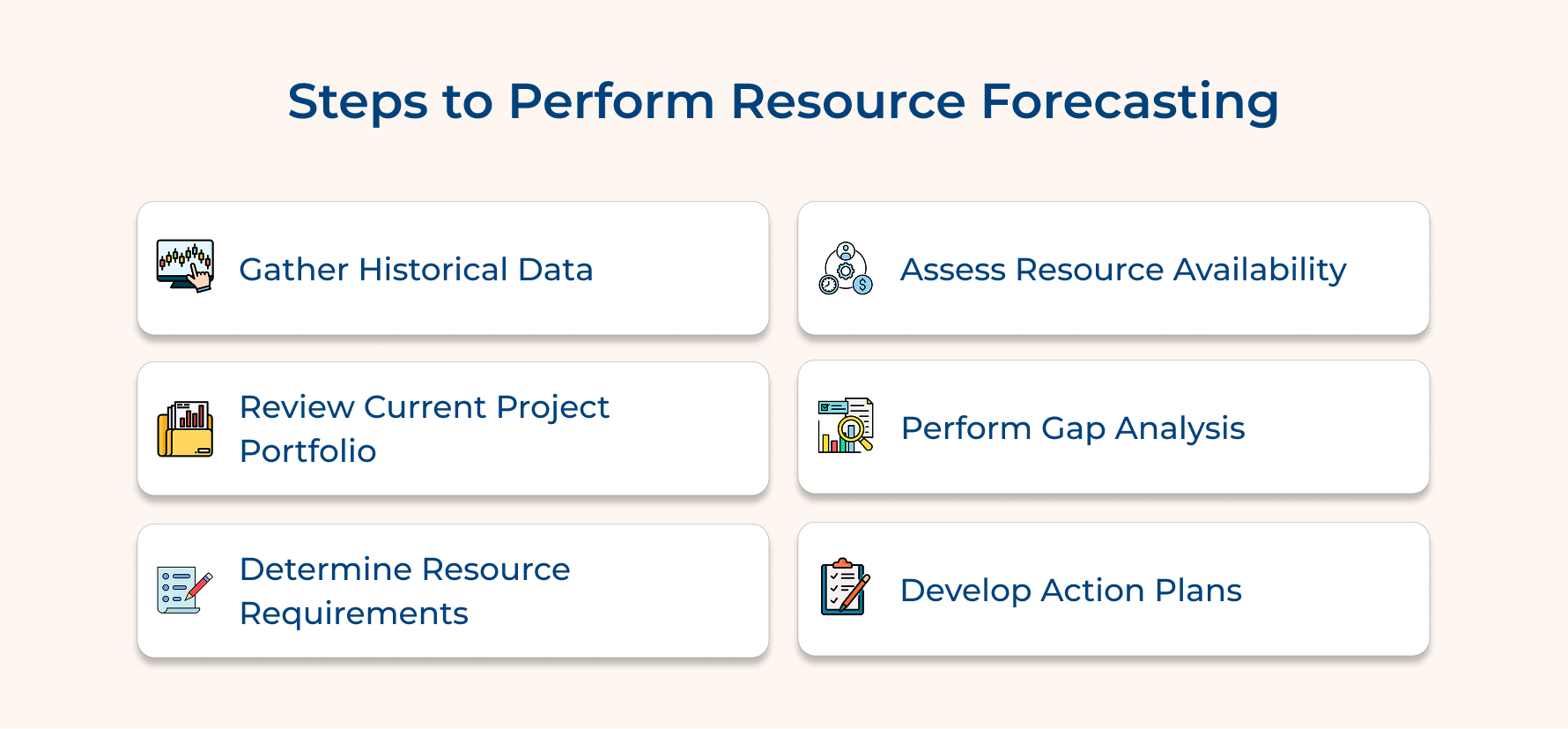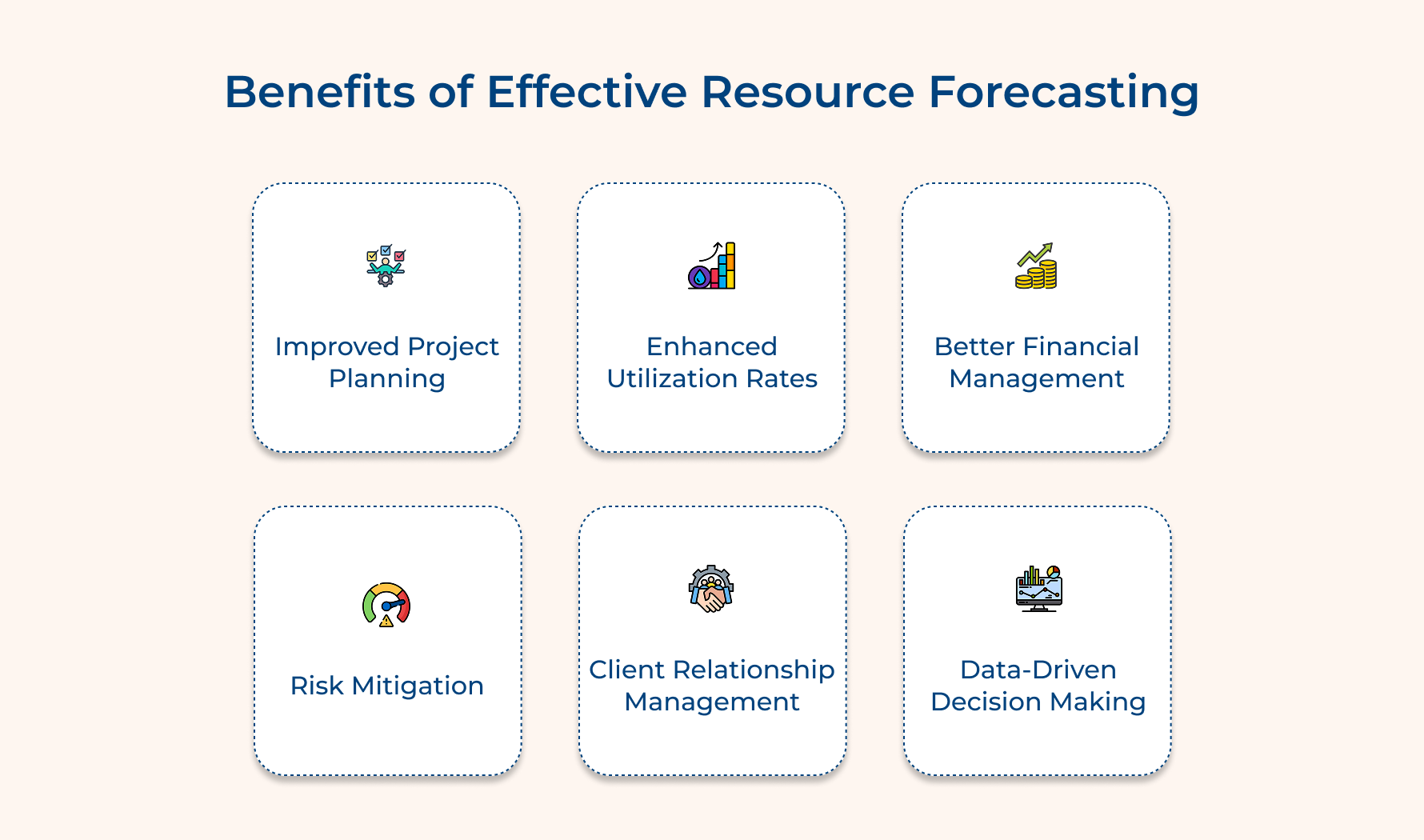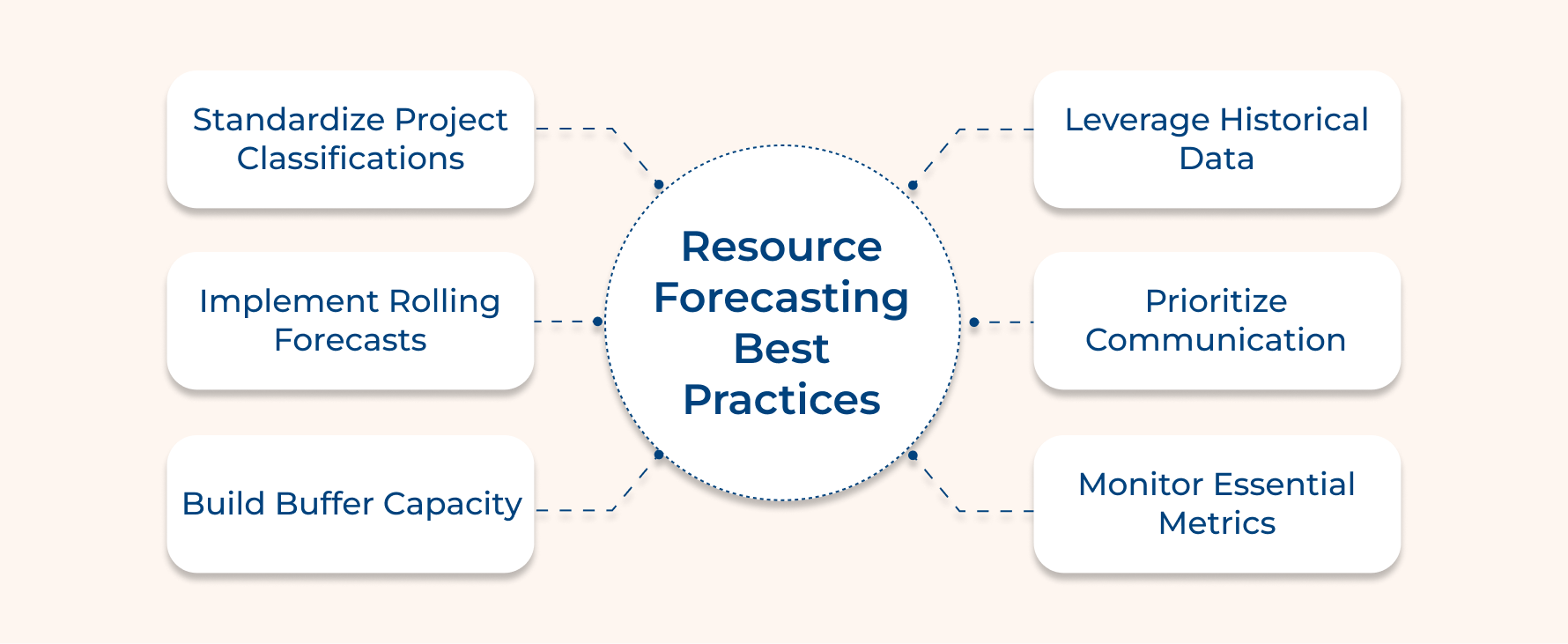What is Resource Forecasting? Benefits & Comprehensive Guide

Key Highlights:
- Leverage historical data for accurate resource forecasting, using trends to optimize planning and predict seasonal variations.
- Align teams through standardized communication and weekly reviews, ensuring accurate forecasts.
- Build flexibility with cross-trained teams, clear prioritization and buffer capacity, tackling timeline shifts as well as multi-project dependencies.
If your team can predict and plan resource needs accurately, it’s a half battle won to better project performance. However, few companies can do it without the right tools or strategies.
Resource forecasting is more about orchestrating talent, technology, and timing to deliver exceptional client value while maintaining operational efficiency.
As project complexity grows while skill demands evolve, mastering the art of resource forecasting has emerged as a fundamental capability for sustainable growth. It also adds to the competitive advantage in the professional services.
Let’s explore how effective resource forecasting can transform your service delivery and drive business success.
What is Resource Forecasting?
Resource forecasting is all about planning and making sure you have everything you need to keep things running smoothly. It’s a strategic way of predicting and planning for the resources required for future projects, upcoming projects, or day-to-day operations. Essentially, it’s about estimating the type, quantity, and timing of project resources to ensure everything stays on track as well as aligns with your goals.
Getting resource forecasting right can help you make more informed decisions, optimize your resource allocation, and stay ahead of the game. It helps avoid issues like understaffing, resource conflicts, or budget overruns that can quickly derail projects.
Key objectives:
- Optimize resource utilization: Ensure maximum efficiency in resource deployment while minimizing idle time and overallocation.
- Control costs: Enable accurate budgeting and cost management by anticipating resource requirements while preventing last-minute expensive solutions.
- Enhance decision-making: Provide data-driven insights for strategic planning, hiring decisions, and investment in new resources.
- Improve project delivery: Ensure projects have the right resources at the right time to meet deadlines and quality standards.
How to Perform Resource Forecasting in a 6-Step Process
Resource forecasting provides valuable insights into the availability of resources, helping businesses plan effectively. By following a structured 6-step process, you ensure smooth project execution.
Gather Historical Data
Analyzing historical data is a game-changer for improving project progress and resource planning. Let’s explore how to gather data in a step-by-step process,
- Gather and Analyze Historical Data
Start by collecting information from past projects, such as resource utilization patterns, project timelines, effort tracking, team structures, and performance metrics. This helps create a clear picture of how resources were used and the factors that influenced project progress. - Leverage Historical Trends for Better Forecasting
Historical data acts as a reliable guide, offering insights into resource consumption patterns and realistic benchmarks for similar projects. It minimizes guesswork by basing predictions on actual project performance rather than assumptions. - Build Standard Resource Templates
Use resource management software to analyze historical trends and create standard templates for projects with similar scopes. You get to predict seasonal variations and estimate resource needs for new opportunities more accurately. - Compare and Establish Baselines
Evaluate similar projects to identify trends and establish baseline estimates. It ensures future resource planning is aligned with proven data, improving efficiency while also reducing errors.
Actionable Tips:
- Create detailed project closure reports capturing actual resource usage, challenges faced, and variances from the original estimates.
- Use resource management software to maintain a central repository of historical data with consistent categorization and regular quality checks to ensure accuracy.
Review Current Project Portfolio
A portfolio review is an essential step in resource forecasting. It involves the following steps,
- Taking a close look at all active and pipeline projects
- Understanding where resources are currently allocated
- Assessing upcoming demands based on the likelihood and timing of future projects.
The process gives you a clear picture of your commitments and what’s on the horizon. Map out current resource usage and analyze potential demands to spot immediate resource constraints as well as plan proactively for upcoming needs.
Make this process more effective by creating resource heat maps to visualize how resources are distributed across projects. Develop probability-weighted resource forecasts for pipeline projects, helping you identify potential conflicts or capacity constraints early.
Pro Tips:
- Use a real-time project dashboard to track resource allocation percentages and availability at a glance.
- Conduct weekly pipeline reviews with your sales team to update project probabilities and timelines, keeping your forecasts accurate.
Determine Resource Requirements
Resource requirements analysis involves breaking down projects into specific roles, skills, and effort needs, considering both projects as well as non-project activities.
Detailed requirements analysis ensures all resource needs are identified and properly quantified. It helps prevent resource shortages and ensures appropriate skill matching for project success.
Create role-based resource templates for different project types. Develop skill matrices matching project needs. Calculate total effort requirements including overhead activities.
Tips to Consider:
- Build standardized resource requirement templates for common project types with clear skill definitions.
- Include buffer time in calculations to account for non-project activities and unexpected demands.
Assess Resource Availability
Assessing resource availability is all about evaluating skills, constraints, and commitments. It helps you make smarter allocation decisions as well as avoid overloading resources.
- Create a Clear Inventory of Resources
List all your current resources, including their skills, capacity, and any constraints that might affect their availability. It gives you a detailed understanding of what’s truly at your disposal. - Identify Capacity Constraints and Opportunities
Understanding real-time resource availability helps pinpoint potential bottlenecks and areas where you can optimize capacity. - Build Resource Calendars
Use resource calendars to map out availability patterns, making it easier to schedule tasks and projects without overloading your team. - Maintain Updated Skills Inventories
Keep a regularly updated record of your team’s skills and expertise. It aligns the right resources to the right projects seamlessly. - Calculate Effective Capacity
Go beyond surface-level availability by factoring in constraints like existing commitments, vacations, or unexpected downtimes. This way, you know that you’re working with accurate capacity numbers for better planning.
Actionable Tips:
- Implement a skills database with regular updates from team members and managers.
- Create capacity calculators that account for holidays, training time, and administrative tasks.
Perform Gap Analysis
Gap analysis helps you compare resource demand with available capacity. The process identifies where there are shortages, surpluses, or mismatches in skills or timing. Hence, allowing you to address potential issues before they affect project delivery.
Conducting a gap analysis helps you spot resource challenges early and take proactive steps like hiring, training, or reallocating resources. It’s a strategic approach to ensuring your team is always prepared for upcoming projects and their requirements.
Make the analysis more effective by creating detailed reports that highlight resource deficits or surpluses. Incorporate timing-based capacity views to align resource availability with project schedules. Pay close attention to critical skill shortages that need immediate resolution to keep things on track.
Tips to Consider:
- Use visual heat maps to easily spot capacity gaps and surpluses over different periods.
- Schedule regular gap analysis reviews and establish clear escalation processes to address critical shortages quickly as well as efficiently.
Develop Action Plans
Action planning is all about turning insights into actionable steps to address resource gaps effectively. By creating clear strategies, you can ensure your team is equipped to meet project demands and avoid disruptions.
- Identify Key Resource Gaps
Pinpoint the specific shortages or skill gaps that need immediate attention. - Plan for Hiring
Develop a hiring plan with clear timelines to bring in the right talent for critical roles. - Focus on Training
Create training programs to upskill your team and address skill mismatches. - Engage External Resources
Build relationships with contractors or external vendors to provide additional support when needed. - Monitor Progress
Regularly review your action plans to ensure they’re on track and adjust as necessary for better results.
Pro Tips:
- Create action plan templates with clear owners, timelines, and success metrics.
- Set up monthly review meetings to track progress on action plan implementation.
Benefits of Effective Resource Forecasting
Effective resource forecasting ensures you’re always prepared to meet project requirements without overextending your team. Let’s delve into other forecasting aspects that benefit you in the long run.
Improved Project Planning
With a solid resource forecast, service firms can plan project timelines with confidence, ensuring the right consultants and specialists are available when needed most. Smart planning helps avoid delays and keeps clients happy with reliable delivery schedules.
Enhanced Utilization Rates
Resource forecasting helps distribute workloads effectively across teams, optimizing utilization rates and balancing efforts. Hence, your consultants can maximize billable hours while preventing burnout and maintaining top-notch service quality.
Better Financial Management
Accurate forecasting means you can predict revenue streams, manage cash flow, and control project costs more effectively. With strategic planning, you can price services correctly while aligning resource costs with expected project revenue.
Risk Mitigation
Spotting potential resource constraints early you can create contingency plans to keep projects on track. Proactive planning minimizes risks like delays, cost overruns, or quality issues that could harm your reputation.
Client Relationship Management
When you have a clear picture of your resource availability, you can confidently commit to new client projects without compromising the quality of existing ones. It ensures you deliver on promises and maintain strong, long-term client relationships.
Data-Driven Decision Making
Resource forecasting taps into historical data and trends to predict future needs. These actionable insights improve decision-making on staffing, project prioritization, and overall strategy, driving better results across the board.
Best Practices for Resource Forecasting
Mastering resource forecasting requires more than just tools; it’s about following proven strategies to align resources with project demands effectively. Let’s explore a few of them here.
Standardize Project Classifications
Create clear project categories and complexity levels to enable consistent estimation. Establish standard effort metrics and resource requirements for similar project types, allowing reliable forecasting based on historical patterns.
Implement Rolling Forecasts
Maintain shorter, more frequent forecast updates (4-6 weeks) alongside long-term plans. Regular reviews and adjustments help maintain accuracy while accommodating changing business conditions as well as project demands.
Build Buffer Capacity
Reserve 10-15% capacity for unexpected demands and opportunities. Smart buffer planning prevents resource overallocation while maintaining flexibility for urgent client requests or project escalations.
Leverage Historical Data
Analyze past project data to identify patterns in resource utilization and project delivery. Use actual vs. planned variance analysis to refine future estimates as well as improve forecast accuracy.
Prioritize Communication
Establish regular touchpoints between sales, delivery teams, and resource managers. Open communication channels ensure timely updates about pipeline changes, project status, and resource availability.
Monitor Key Metrics
Track essential indicators like utilization rates, project profitability, and forecast accuracy. Regular metric reviews help identify improvement areas and maintain optimal resource allocation.
Challenges of Resource Forecasting
Resource forecasting isn’t without its challenges, as unpredictable variables can complicate accurate planning. Identifying and addressing these hurdles is key to maintaining efficiency as well as ensuring project success.
Unpredictable Project Timelines
Projects often encounter unexpected delays, scope changes, or sudden accelerations, throwing resource plans into chaos. To tackle this, build flexible resource pools with cross-trained team members who can switch between tasks as needed.
Keep a 15-20% capacity buffer to handle timeline shifts smoothly. Regular project timeline reviews and clear escalation protocols for resource conflicts can also help keep things on track.
Data Quality Issues
Inaccurate or incomplete historical data can make forecasting a challenge, leading to unreliable estimates. The solution? Standardize time-tracking and project classification processes across your organization.
Make project closure reports mandatory to capture actual resource usage, and conduct regular data quality audits. Using specialized resource management tools ensures consistency and accuracy.
Skill Matching Complexity
Finding the right skill combinations for complex projects can feel like solving a puzzle. Maintain detailed skill matrices for your team, including their proficiency levels and certifications.
Offer internal training programs for high-demand skills and create development paths aligned with future needs. For niche skills, build relationships with specialized contractors to fill the gaps when needed.
Communication Gaps
When sales, delivery teams, and resource managers aren’t on the same page, it can lead to inaccurate forecasts as well as conflicts. Fix this with weekly pipeline review meetings that bring everyone together.
Use standardized templates for resource requirements and invest in a centralized resource management system that all stakeholders can access. Clearly define roles and responsibilities in the forecasting process to avoid misunderstandings.
Multi-project Dependencies
Managing resources across multiple projects can feel like juggling too many balls at once. Implement project portfolio management practices with clear prioritization rules to simplify allocation.
Use resource management tools that provide visibility across all projects, and hold regular capacity planning meetings to address cross-project dependencies. Establish clear escalation paths to resolve resource conflicts quickly.
Cost Management Pressures
Balancing resource costs with project profitability while maintaining quality is a constant challenge. Create clear guidelines for mixing junior and senior resources on different projects, while using profitability models that account for various resource scenarios.
Regularly review rate cards and keep a close eye on utilization rates along with bench costs. For cost-effective options, consider building partnerships with offshore resources that align with your quality standards.
Maximizing Profitability Through Strategic Resource Forecasting
Mastering resource forecasting has become a strategic imperative rather than a mere operational task. The ability to accurately predict as well as plan resource needs directly impacts project success, client satisfaction, and bottom-line results.
While perfect forecasting remains challenging, successful firms demonstrate that data-driven planning and strategic buffer management can transform resource forecasting from a pain point into a competitive advantage. Those who embrace this challenge while maintaining agility find themselves better equipped to scale their practices, take on complex projects, and build lasting client relationships.
Limit time — not creativity
Everything you need for customer support, marketing & sales.
Neeti Singh is a passionate content writer at Kooper, where he transforms complex concepts into clear, engaging and actionable content. With a keen eye for detail and a love for technology, Tushar Joshi crafts blog posts, guides and articles that help readers navigate the fast-evolving world of software solutions.


